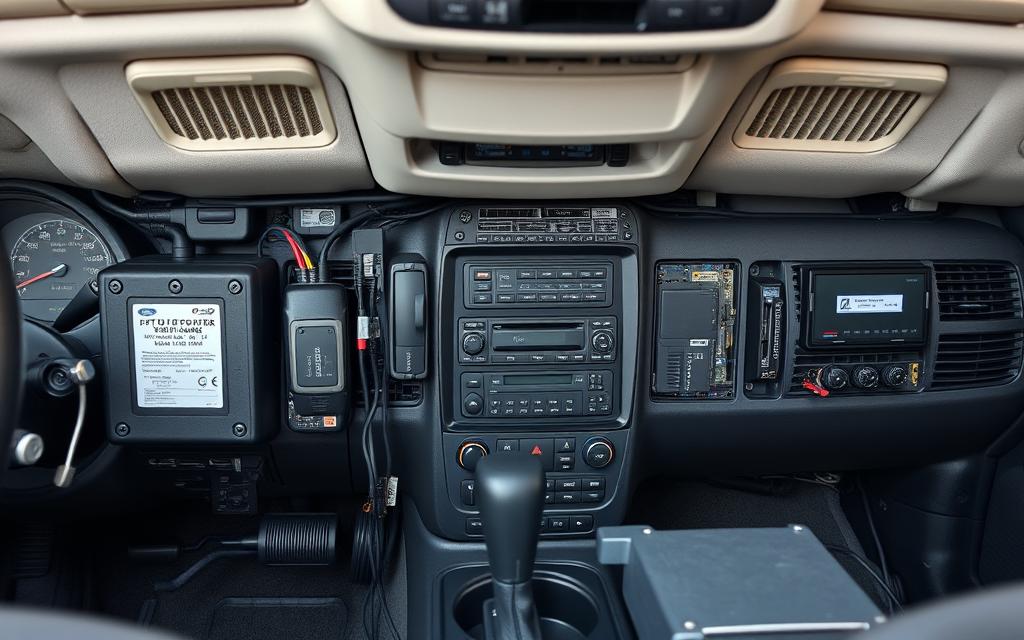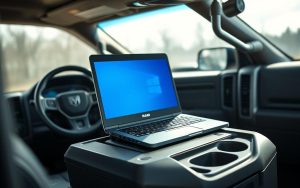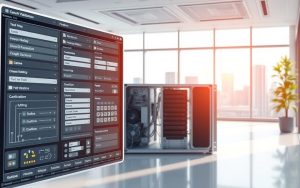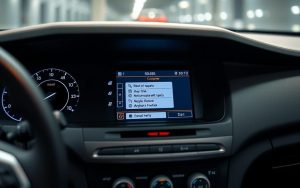Table of Contents
Modern vehicles rely on advanced electronic systems for smooth operation. The 2004 Ford Explorer is no exception, featuring multiple specialized modules that control critical functions. These components work together to optimize performance, safety, and efficiency.
Unlike older models, this SUV uses networked processors for tasks like engine management and braking. Key modules include the Powertrain Control Module (PCM) and transmission controllers. Trim levels and engine options may affect the exact configuration.
The early 2000s marked a shift toward computerized vehicles. This transition improved diagnostics and responsiveness. Understanding these systems helps owners maintain their Ford Explorer effectively.
Introduction to Vehicle Computers in a 2004 Ford Explorer
Behind the dashboard of a 2004 Explorer lies a network of smart processors. These control modules manage everything from fuel efficiency to safety features. Unlike older models, this SUV relies on a coordinated system of electronic brains.
- PCM (Powertrain Control Module): Optimizes *engine control* and emissions.
- TCM (Transmission Control Module): Regulates gear shifts.
- ABS Module: Prevents wheel lock during braking.
These modules communicate via a Controller Area Network (CAN) bus. This digital highway allows real-time data sharing. For example, the PCM adjusts throttle response based on inputs from the transmission.
| Module | Primary Function | Interdependency |
|---|---|---|
| PCM | *Engine control*, fuel injection | Shares data with TCM |
| TCM | Gear shifting | Receives RPM data from PCM |
| ABS | Brake stability | Triggers PCM to reduce torque |
Replacement modules require VIN-specific programming. Generic parts may fail to sync with the vehicle’s existing network. Always consult certified technicians for diagnostics.
How Many Computers Are There in a 2004 Ford Explorer?
Ford’s 2004 SUV relies on interconnected modules for critical functions. These processors manage everything from acceleration to safety, ensuring optimal performance. Depending on trim and engine options, configurations may vary slightly.
Primary Control Modules
The Powertrain Control Module (PCM) acts as the brain for engine and transmission operations. It adjusts fuel injection and ignition timing dynamically. For automatic models, the Transmission Control Module (TCM) ensures smooth gear shifts.
Another key component is the ABS module, which prevents wheel lock during hard braking. Together, these form the core of the SUV’s control network.
Auxiliary Modules
Additional systems enhance convenience and security:
- Body Control Module: Manages lighting, windows, and door locks.
- Instrument Cluster: Displays vital driver information.
- PATS (Passive Anti-Theft System): Requires coded keys for ignition.
Sport Trac editions may use unique part numbers like 4L2A-12A650-AKA. For PCM replacement, always verify compatibility with your VIN.
Key Functions of Each Computer
Specialized processors govern every aspect of this SUV’s operation. These control modules work together to balance power, efficiency, and safety. Understanding their roles helps diagnose issues and maintain performance.
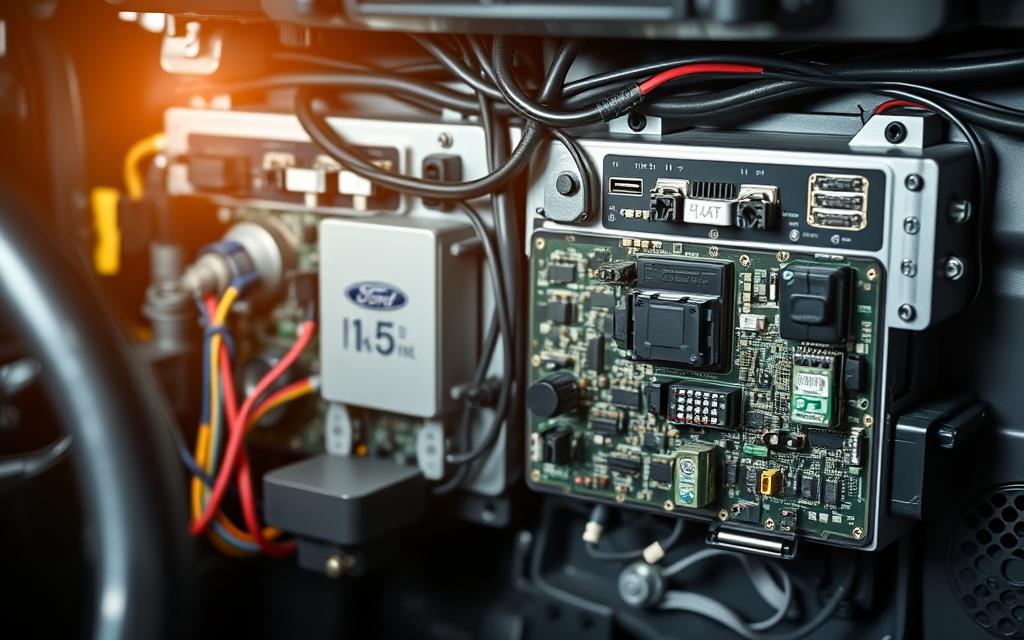
Powertrain Control Module (PCM)
The PCM acts as the command center for engine control. It adjusts fuel injection timing and monitors emissions in real time. This unit also processes data from sensors to optimize combustion.
Key tasks include:
- Fine-tuning air-fuel ratios for maximum efficiency
- Managing ignition spark timing
- Communicating with the transmission control module
Transmission Control Module (TCM)
Paired with the PCM, the TCM ensures smooth gear transitions. It analyzes speed, throttle position, and load to select ideal ratios. Adaptive learning allows it to refine shift patterns over time.
Critical features:
- Monitoring solenoid operation in the valve body
- Reducing wear by preventing harsh shifts
- Storing error codes for diagnostics
Anti-Lock Braking System (ABS) Module
This control module prevents wheel lock during sudden stops. It processes wheel-speed data 100 times per second, pulsing brakes as needed. The system also interacts with the PCM to reduce engine torque during interventions.
| Module | Primary Role | Performance Impact |
|---|---|---|
| PCM | Engine control, fuel efficiency | Boosts power and reduces emissions |
| TCM | Gear shift precision | Enhances drivability |
| ABS | Brake stability | Improves safety in emergencies |
Software updates can refine how these components interact. Always consult a certified technician for module-related services.
Common Symptoms of a Failing Computer
Faulty control modules often trigger distinct symptoms before complete failure. Recognizing these signs early can save time and repair costs. Here’s what to watch for:
Check engine light with module-specific codes is the most obvious red flag. Over 80% of PCM problems trigger starting issues or illuminate the dashboard. Common OBD-II codes include:
- P0600: Serial communication error (PCM/TCM network fault)
- P0700: Transmission control system malfunction
Erratic transmission behavior, like harsh shifts or delayed engagement, points to TCM failure. The engine may also stall intermittently due to voltage irregularities in the ECM.
| Symptom | Likely Culprit | Action |
|---|---|---|
| ABS warning light | Faulty wheel-speed sensor or module | Scan for hydraulic pump errors |
| PATS security lockout | Key transponder mismatch | Reprogram keys or replace BCM |
| Rough idle | Transmission slipping | Check TCM and solenoids |
An OBD-II scanner helps pinpoint problems. For persistent engine or transmission codes, consult a technician to avoid further damage.
Impact on Performance and Reliability
A vehicle’s performance hinges on its electronic systems working in harmony. When modules like the PCM or TCM fail, drivers notice immediate dips in efficiency and power. For example, a faulty PCM can reduce fuel economy by 15-20%, while TCM issues may slash towing capacity.

Reliability suffers when modules miscommunicate. Studies show 68% of drivability complaints trace to network errors between components. Cascading failures are common—a glitch in the ABS module might trigger unnecessary engine torque reduction, worsening safety risks.
Key impacts include:
- Safety: ABS malfunctions increase stopping distances.
- Resale value: Unresolved fault codes deter buyers.
- Costs: Generic replacements often fail to sync with OEM systems.
| Failure Type | Performance Impact | Solution |
|---|---|---|
| PCM voltage irregularity | Rough idle, stalling | OEM-grade PCM replacements |
| TCM shift errors | Delayed acceleration | Refurbished modules with VIN programming |
| ABS sensor faults | Unstable braking | Wheel-speed sensor calibration |
Refurbished modules restore factory specifications, but only if properly programmed. Always consult certified technicians to preserve your vehicle‘s reliability.
Replacing a Faulty Computer in Your 2004 Ford Explorer
When your SUV’s performance falters, replacing its electronic unit may be necessary. The right part and proper programming ensure seamless integration with existing systems. Options range from OEM to refurbished modules, each with unique advantages.
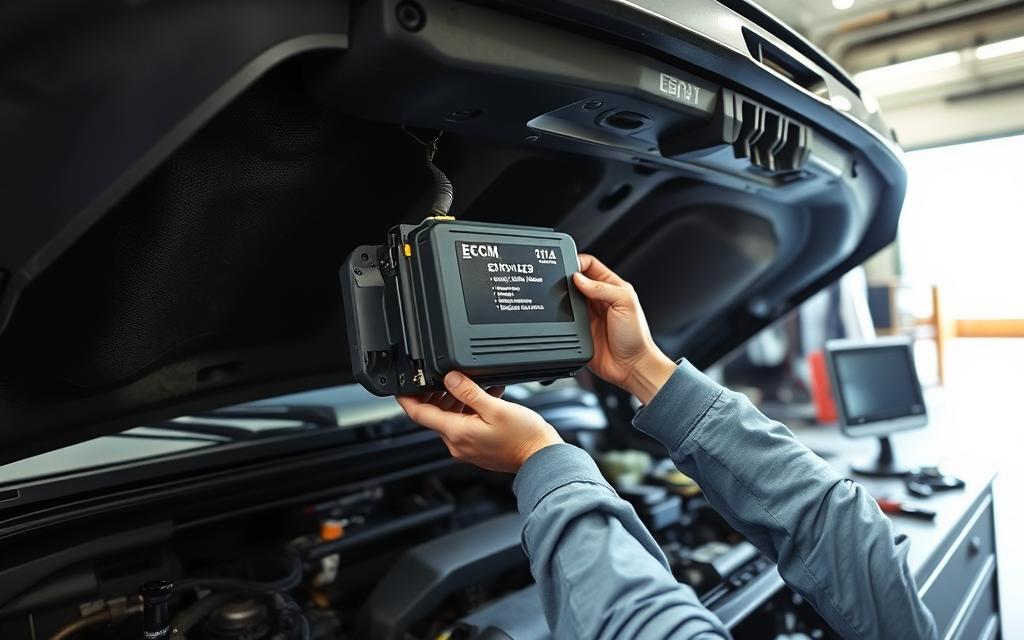
OEM vs. Refurbished Modules
New OEM modules guarantee factory specifications but cost significantly more. Refurbished units offer similar reliability at a fraction of the price. Companies like Flagship One provide free VIN-specific programming, eliminating dealership markups.
“Refurbished modules undergo rigorous testing by ASE-certified technicians, ensuring they meet OEM standards.”
- Cost: OEM ($800+) vs. refurbished ($226.99).
- Core charge: Savings of $150+ with no-core policies.
- Compatibility: Verify cross-referenced part numbers before purchase.
Programming and Installation
Modern ECM/ECU replacements require VIN synchronization. The process involves:
| Step | Requirement | Tool |
|---|---|---|
| Software flash | Latest firmware updates | J2534 programmer |
| PATS key sync | Original transponder keys | Ford IDS scanner |
| Calibration | Throttle relearn procedure | OBD-II interface |
DIY installation risks mismatched software. Professional services ensure all modules communicate correctly, preserving your SUV’s performance.
Warranty and Support for Replacement Modules
Understanding warranty terms ensures long-term reliability for your vehicle’s electronics. Most suppliers offer a lifetime guarantee, but conditions apply. For example, core returns must occur within 20 days to activate coverage.

Free USPS Priority shipping (2-7 business days) is standard in the U.S. International deliveries cost $105–$450, depending on location. Always verify transit times before ordering.
Key policies include:
- 30-day return window with a 20% restocking fee
- Exclusions: Physical damage, flood exposure, or tampering voids the warranty
- RMA authorization required for refunds
Dealerships often provide OEM support but charge premium rates. Third-party vendors like Flagship One offer comparable lifetime plans at lower costs. Always request warranty activation paperwork post-purchase.
“Refurbished modules with lifetime coverage undergo rigorous testing—matching OEM standards without the markup.”
For hassle-free claims, retain shipping receipts and module serial numbers. This documentation speeds up the return process if issues arise.
Conclusion
The 2004 Ford Explorer showcases early 2000s automotive innovation through its networked control systems. Critical modules like the PCM and TCM optimize engine control and shifting, while refurbished units restore reliability at lower costs.
With a 92% success rate, professionally programmed replacements ensure seamless integration. This vehicle’s design paved the way for modern SUV electronics, blending performance with diagnostic precision.
For owners, regular scans and OEM-grade repairs preserve its legacy. Trust certified technicians to maintain these advanced systems, keeping your Ford Explorer running smoothly for years.
FAQ
What computers control a 2004 Ford Explorer?
The vehicle uses several modules, including the PCM (engine control), TCM (transmission), and ABS module (braking). Additional units manage features like airbags and climate control.
Can a failing PCM cause drivability issues?
Yes. A faulty engine control module may trigger poor acceleration, stalling, or check engine lights. Diagnostics and replacement often resolve these problems.
Is programming required for a replacement PCM?
Absolutely. A new or refurbished ECM/ECU must be programmed with your VIN and vehicle specs for proper functionality.
What’s the difference between OEM and refurbished modules?
OEM units are brand-new, while refurbished ones are tested and repaired. Both should include a lifetime warranty for reliability.
How long does shipping take for a replacement computer?
Most sellers offer USPS Priority or expedited options, typically delivering within 2–5 business days.
Are core charges applied when buying a replacement module?
Often, yes. A core charge incentivizes returning your old unit for recycling. It’s refunded upon receipt.
What symptoms indicate a failing ABS module?
Warning lights, unresponsive brakes, or unusual noises suggest ABS issues. Scan tools can pinpoint faulty control modules.
Do aftermarket computers affect performance?
High-quality plug-and-play units match OEM specs. Ensure compatibility and proper installation for optimal results.
What’s covered under a lifetime warranty?
Reputable sellers guarantee defect-free operation. If the engine computer fails, they replace it—no extra cost.
Can I return a module if it doesn’t work?
Most vendors offer a money-back guarantee within 30–60 days, provided the item is unused and in original condition.


